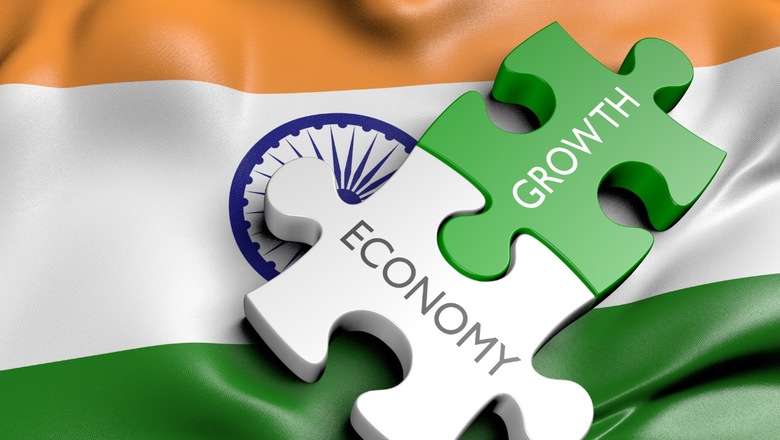
views
Rocketry Bang
The year 2024 has just begun. But India is already on the prowl with the country having gotten off to high trajectory with a rocketry bang. On January 1, India pole-vaulted to become the second country in the world after the US to launch XPoSat (X-ray Polarimeter Satellite) to study astronomical objects like black holes.
With a projected GDP growth rate between 6.5-7 per cent, i.e. more than double of the global growth rate, India is on the fast lane to become a $4 trillion economy this year. With a whopping Rs 1,64,882 crore collection of GST in December (a 10 per cent increase), the country is set to beat the FY2024 budget estimates.
‘Pushpak Viman’ touched the tarmac of Maryada Purushottam Shri Ram Airport well ahead of time and well in time for Ram Mandir’s consecration ceremony that will usher in a new era of domestic and international religious and spiritual tourism.
Prime Minister Modi has eschewed populism in the election year, with the government doggedly refusing to increase the interest rate of small savings schemes.
Above is a good omen for India in the year 2024.
The Verdict Time
2024 is going to be an election year with the Lok Sabha elections scheduled in April-May. I possess no political punditry and the Indian electorate is capable of springing surprises. Nonetheless, as a keen observer of the changing national scenario, my informed guess — based on the performance perception of 10 years of Modi Raj, fractured Opposition, recent survey reports and some hard data crunching — is that the return of Modi 3.0 is a near certainty, whether BJP’s new slogan ‘Teesri baar Modi sarkar, abki baar 400 paar’ fructifies, whether it gets simple majority like 2014 or cobbles together a government with NDA partners.
My dreams, aspirations, and agenda for India in 2024 have factored in Modi 3.0. Also, in the most unlikely scenario of the Opposition becoming victorious, what I present below, remains my blueprint for making 2024 the defining year to jumpstart the journey to make India a developed country by 2050, if not 2047.
Dreams, Aspirations and Agenda
The fulcrum of my audacious dreams (25-year horizon), aspirational aspirations (5-year horizon) and doable blueprint agenda (1-year horizon) are six-fold. And these revolve around-
- Breakthrough economic growth
The minimum requirement to become a developed nation must be weaved around making true the dream of continuous 25 years of sustained annual GDP growth of more than 10 per cent. And the pathway begins with India breaking the mould with more than 8 per cent GDP growth in 2024 and over 9 per cent aspirational growth over the next five years.
- On to the high road to high per-capita income
Notwithstanding the fact that India is sure to surpass the latest IMF prediction of becoming the world’s fourth largest economy in 2025 and third largest in 2027 (with projected economy size of $5.4 trillion), when it comes to the per capita income, India ranks 139th by GDP (nominal) and 127th by GDP (PPP). The dream must be to catapult the rank of per-capita income to 25th in 25 years with the five-year aspiration to enter the league of the top 100. This will need a manifold increase from the present $2,450 per capita income to $12,670 of China and $47232.27 of the UK. It is a long, tortuous untravelled road and the purposive journey with a resolute action plan must begin in 2024.
- Bridging the yawning inequality gap
India with a 144 crore population just turned or is about to turn the most populous country in the world. And the population is set to continue to grow to 166.8 crore by 2050. This means that the per capita income growth will be under severe pressure unless there is a deliberate calibrated well-defined pathway to massive reduction of poverty with well-targeted distributive justice. Poverty is a multidimensional phenomenon and India has done well by bringing 415 million people out of the dungeon of poverty in the last 15 years. Still, the country is home to the world’s largest population of poor, surviving daily at an income of $2.15 or below. 2024 must be the Shankhnaad year to eliminate absolute poverty by 2050.
- Reaping the population dividend
Much of the globally developed North and the population of China, Japan, and South Korea in Asia, is both ageing and shrinking, while India is a country of youth and will witness an extraordinary population dividend for many decades, the longest such seen by any country. It is this population dividend that holds the key to converting India into a developed country in the next 25 years. But the pathway to reap the benefit of population dividend is full of headwinds. The year 2024 must create a modular achievable pathway to reach where the country must, – by converting headwinds into tailwinds.
- From employment seekers to wealth generators
Ever since Macaulay’s education system got a tee-hold in India, the country turned into an ocean of illiterate unemployed, literate unemployed, educated unemployable and unemployable job seekers. A cursory look at CSSO and CMIE statistics indicate that despite the relative reduction in unemployment, an unemployment rate of around 10 per cent is always around the corner. In an era of shrinking governmental and public sector jobs, India must become the hub of millions of youth disruptors, who change the tide from millions of jobseekers to millions of wealth creators and job givers. That is the pathway to the actualisation of a developed country’s dream in the next 25 years.
- Environmental and ecological sustainability
If the 25-year dream is to become Samarth, Atma-Nirbhar Viksit Bharat, the road begins with integrating growth with intragenerational and intergenerational environmental and ecological sustainability. There has been too much huff and puff, sabre-rattling, and fits and starts noises around the subject. But sustainability is no longer the desirability issue, it is the survival issue. The time starts now.
Action Points
If the above-mentioned dreams, aspirations, and agenda must turn into reality, India must at once get going on the war footing on the following 11 action points-
Fourth generation reforms
India lost decades to socialism and the license permit raj. Despite the three generations of reforms initiated by Manmohan Singh, Atal Bihari Vajpayee and two terms of Narendra Modi, the country is not yet fully out of the yoke of the past. It is time now to unleash the fourth-generation multi-pronged reforms cutting across sectors. And the time begins on February 1, when the present government presents its last budget-cum vote of accounts. Undeterred by Kaun Banega Pradhan Mantri imbroglio eschewing all populism, it is time to showcase the new reform agenda to unleash the animal spirit.
Infrastructure
As India entered the new millennium, its creaky infrastructure was the biggest sore point. Infra rejuvenation began in the Vajpayee era, crawled in the UPA era and transformed in the last ten years. But the truth beckons that if the country must become a developed nation in 25 years, multiple infrastructure dreams must be weaved and actualised. Infrastructure has the capability to add an additional 2 per cent annual growth to the GDP. The infra push needed is myriad and the selected three are here-
- Multimodal long-distance transport
Fast upgradation of the cross-country transport infrastructure holds the key to fast, efficient, and effective mobility of people and goods. The last two decades of growth in transport infrastructure has been lop-sided and more tilted towards roads and highways. In 2024, India must overturn the paradigm and take the vow to triple the length of railways, from 70000 km to 210000 km in the next 25 years, including 20000 km of dedicated freight corridors and 2000 km of high-speed passenger corridors (300-350 kmph) and 60000 km of semi high-speed 250 kmph corridor.
During the same period, the country also needs to increase operational public airports from 150 (Ayodhya is the latest) to 1000 (America has 5000 public airports and 10000 plus private airports). It also has to double if not triple four-lane highways and expressways and substantially up the capacity of ports and coastal waterways.
For these to happen, the country will need a new time-bound ultrafast execution discipline and the construction in record time of Ayodhya’s Ram Temple and before that, the new Parliament building has shown that where there is a will there is a way.
- Sustainable urban transport
At present, more than 50 crore Indians living in cities and towns contribute 66 per cent of the national GDP, this number will radically change to around 85 crore city dwellers contributing around 80 per cent of GDP. Apart from a massive increase in the population of current cities, India will need hundreds of new cities. Indian cities are transport gridlocked. The biggest sufferers are pedestrians and cyclists (who account for around 50 per cent of trips), who are devoid of any infrastructure. The entire paradigm of urban transport must be changed to symbiotic development and integration of multimodal sustainable urban mobility.
It does not merely mean more metro rail, but every city depending upon the city size and the mobility pattern to have a complete hierarchy of sustainable, comfortable, and affordable infrastructure.
- Water, water everywhere, water, water nowhere
Make no mistake, India, the biggest user of groundwater in the world, faces an existential water crisis. The country, which is home to 18 per cent of the world’s population, has fresh water to cater to the needs of merely 4 per cent. The groundwater table is severely depleted and polluted. And global warming means either too much rain (flood) or too little rain (drought). The country needs to redream and recalibrate its water future and let 2024 show the way. Water crisis not only affects agriculture and drinking water, but it is also critical for every sector of the economy.
Agriculture
Agriculture with forestry and fishery accounts for 18 per cent of the GDP but more than 60 per cent of the country’s population depends on it. Worse, agriculture is at a subsistence level with massive rural unemployment and underemployment. India not only has to drastically transform its agricultural practices to feed 160 crore Indians in the next 25 years but also will have to be an export hub. Rome was not built in a day, and nothing big has happened to Indian agriculture since the Green Revolution of the 1960s. The year 2024 must begin rebooting of the agriculture and the economy.
Manufacturing
The Gross Value added of the industry in FY23 was 28.25 per cent and the breakup was mining and quarrying at 2.36 per cent, construction at 8.19 per cent and manufacturing a pity 14.7 per cent. It does not sound too good for India’s dreams and aspirations. There is an opportunity here. The Chinese population is shrinking and greying, and its economy has been under stress even since Covid-19. Westerners are taking their money and factories out of China. But there is intense competition among developing nations, from Bangladesh to Vietnam, every country is in the race to become the factory of the world. Let 2024 lay the pathway and red carpet for India’s dream to be the factory of the world.
Services
Services with a massive contribution of 53.34 per cent to the GDP are the toast of the Indian nation. And the relative contribution of different subsectors of the services is – public administration, defences, and other services (13.91 per cent), financial real estate and professional services (21.42 per cent) and trade, hotels, transport, communications, and services related to broadcasting (17.98 per cent). The die is cast here. This is one area where the Indian economy can truly leapfrog and grow fast. The country has the raw materials, trained workforce and the whole world is the market.
The caveat is that in the growing pie, the share of administration and defence must come down. And if India must retain its primacy as the world’s capital of the services industry, it has to reinvent the wheel and can no longer compete in the “knowledge economy” merely on cost. India also must turn magnet for trade and tourism. These are the areas where 2024 must recalibrate the dream for Circa 2050.
Consumption
In an uncertain world and the era of growing nationalism and dying globalisation, the major impetus to growth must come from domestic consumption. But there is no magic bullet to increasing consumption. The only way to increase the consumption basket is to fast increase the disposable income and to that end, an increase in real wages both in cities and towns holds the key.
Innovation
India cannot become a developed country with incremental growth, it needs sustainable disruptive double-digit growth for decades. And it is where my innovation dream fits in. The US and China are world beaters in innovation. China has effortlessly transitioned from being the world’s main manufacturing hub to an innovation ecosystem. India has not only to ape China but go a step further on the innovation superhighway with India’s own “next practices,” to paraphrase the world’s noted management Guru, Late Coimbatore Krishnarao (CK) Prahalad.
Education
It does not need rocket science to decipher that despite some centres of excellence here and there, the country’s education system sucks. Skilling, which started with much fanfare, is yet to make a real dent. India needs to drastically up the ante to provide high-quality education to both poor and rich alike, to annually make available the required number with adequate quality of human capital, to populate India’s dream to remain the world capital for the knowledge industry, to become a factory of the world and export maximum number of well-trained Indian professionals to run the economy of greying and shrinking developed nations.
Health
The health of the Indian nation is in existential crisis if not altogether in a coma. Last year’s health budget of Rs 88,956 crore is peanut for its 143-crore population. If we remove the establishment expenditure from the budget, the discrepancy is further glaring. The crisis is across sectors – primary, secondary, tertiary and research and in all the areas of preventive, curative and palliative care. There is a gross shortage of human capital, infrastructure, machinery, and materials.
Unsurprisingly then, even with the unreliable governmental data, the out-of-pocket health expenditure in the country has come down to 47.1 per cent in 2019-20 from 62.6 per cent in 2014-15. Its time is up.
Combating pollution
Air pollution (both ambient and indoor) is killing India, the consensus estimate is more than 2.1 million deaths per annum. Pollutants are known, and so are the effects. Our problem is we don’t even know the extent of pollution nor are we interested in knowing it. The entire 144 crore Indian population is exposed to unhealthy levels of ambient PM2.5 – the most harmful pollutant. Also, the total economic loss to Indian GDP as per the dated data of 2019 is $37 billion i.e., 1.4 per cent of GDP. It is a ‘Wake Up Sid’ moment for the nation.
Reducing corruption
For a nation to become developed, it must first become less corrupt. As per Transparency International Index, India is at 85th position in a list of 185 countries. In my four and a half decades of public life as a banker, civil servant, public sector senior corporate honcho, social worker and impact consultant, I have been witness to the naked dance of the rise of both retail and wholesale corruption. Corruption is a termite. It is time to stop it in its pants. Let 2024 begin with a bang – no more tolerance for corruption and exemplary swift punishment for the perpetrators.
The author is Multidisciplinary Thought Leader with Action Bias and India Based International Impact Consultant. He works as President Advisory Services of Consulting Company BARSYL. Views expressed in the above piece are personal and solely those of the author. They do not necessarily reflect News18’s views.



















Comments
0 comment